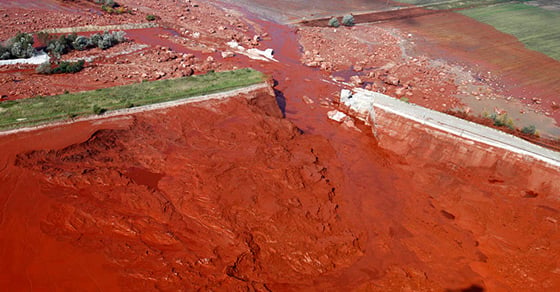Red mud is a byproduct of aluminum production, in which alumina is extracted from bauxite ore via the Bayer process.
Unfortunately, for each ton of aluminum produced, around 1-2 tons of red mud are also produced, creating a massive amount of industrial waste to manage. This red mud, or bauxite residue, represents a significant challenge to the industry due to its highly caustic nature and the significant quantities in which it is produced.
Storage has long been the primary management tool for red mud, but recent disasters, coupled with aging containment ponds and anticipated demand growth for aluminum have the industry looking for better solutions, as is evidenced by the growing body of research around reuse and/or recovery applications.
The Case for Red Mud Reuse
While red mud composition varies based on the source of bauxite and other variables, it is comprised mainly of various oxides (the high iron oxide content found in the residue is what gives red mud its name). Red mud’s extremely high alkalinity, combined with trace heavy metals found in the residue, make it a major risk if not handled properly. Aluminum producers struggle to manage the massive amounts of red mud sludge in a way that minimizes environmental risks and still remains economically feasible.
In 2010, a containment pond wall collapsed in Hungary, causing a flood of red mud to surge through the surrounding area, killing 10 people, injuring over 100 more, and damaging local ecosystems.
As one of the largest industrial by-products (estimates say bauxite residue is produced at a rate of around 150 million tons annually), finding an alternative use for red mud could turn an industry problem into a potential benefit, reducing environmental risks and mitigating the potential for disasters. Additionally, it would relieve the aluminum industry of the significant burden of managing the red mud byproduct.
Beneficial Reuse & Recovery Opportunities
The potential for beneficial reuse and/or recovery applications around red mud runs a wide gamut, with challenges such as heavy metals, high alkalinity, and massive quantities, always at the forefront. Common reuse and recovery endeavors are listed below.
Material Recovery
Despite the significant waste challenge that this industrial byproduct presents, red mud is also a waste rich in resources, containing a variety of materials that could be useful if recovered. The ability to recover such materials becomes increasingly attractive as the world grapples with a growing dependence on finite resources and shifts to a focus on sustainability. Materials commonly targeted for recovery from red mud include:
- Iron
- Rare Earths
- Aluminum
- Titanium
Wastewater Treatment
Red mud has also shown promise for use as an adsorbent, with research ongoing.
The potential to use red mud as an adsorbent in wastewater treatment settings in particular continues to gain attention, as it has been shown to be capable of capturing a variety of pollutants and materials such as heavy metals, phosphate, and even bacteria, among others. With some treatment, red mud-based adsorbents can offer a much needed, low cost option for water and wastewater treatment applications, without presenting toxic risks to the environment.1
Building/Construction Materials
Red mud has been examined for use in a number of different building and construction materials, from cement and bricks, to glass, geopolymers, and more. Similarly, it has been studied for use as a fill material in high-grade road base.
Red mud is not the first industrial byproduct to find use in construction applications; fly ash, a byproduct of coal production is often used as a partial substitute for Portland cement due to its pozzolanic properties.
Other studies have looked at red mud for use in waste gas treatment, as a catalyst, and more. In PVC plastic, red mud has been shown to offer a reinforcing effect when used as a filler, as well as serving as a cost-effective thermal stabilizer.
Feasibility Testing
At the center of research and development around effectively managing red mud is the need for capable testing facilities.
As a material that has long been seen as a waste and only just recently gained interest in reuse and recovery applications, there are few facilities available for testing the feasibility of such processes for red mud. In addition to being a new and uncharted market, testing is also critical when working with red mud due to the widespread variability that can occur across different sources of the residue.
“We’ve always been testing alumina and bauxite materials, but we’ve definitely seen an increase in red mud inquiries over the past few years,” says Alex Ebben, FEECO Process Sales Engineer and thermal processing expert. “There is a huge push to find a better solution for red mud and producers are looking for facilities that can simulate the entire pyro-processing flowsheet and provide extensive data collection. People are excited when they hear that we can offer the testing capabilities they’re looking for.”
FEECO has worked with companies looking to address their red mud problem through batch and pilot-scale testing, including both drying of red mud, as well as reduction roasting and other pyrometallurgical techniques utilizing rotary kilns.
Conclusion
Red mud remains an economic and environmental management challenge for the aluminum industry. Research and development around the recovery of valuable materials from red mud and beneficial reuse applications continue to grow, with promising outlets including iron, titanium, aluminum, and rare earth recovery, as well as use as an adsorbent in wastewater treatment, soil remediation, building materials, and much more.
FEECO offers a number of rotary kilns and other testing options for the pyrometallurgical treatment of red mud. We can also aid in process scale-up once the process data has been gathered, and can even manufacture custom rotary dryers and kilns to carry out the process.
For more information on our red mud, bauxite, or alumina testing capabilities, contact us today!
Image: Red mud alumina plant accident, Devecser, Hungary – Source: State Secretariat for Government Communications (Hungary)

